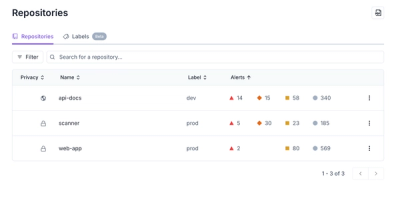
Product
Redesigned Repositories Page: A Faster Way to Prioritize Security Risk
Our redesigned Repositories page adds alert severity, filtering, and tabs for faster triage and clearer insights across all your projects.
choreographer allows remote control of browsers from Python. It was created to support image generation from browser-based charting tools, but can be used for other purposes as well.
Kaleido is a cross-platform library for generating static images of plots. The original implementation included a custom build of Chrome, which has proven very difficult to maintain. In contrast, this package uses the Chrome binary on the user's machine in the same way as testing tools like Puppeteer; the next step is to re-implement Kaleido as a layer on top of it.
choreographer is a work in progress: only Chrome-ish browsers are supported at the moment, though we hope to add others. (Pull requests are greatly appreciated.)
Note that we strongly recommend using async/await with this package, but it is not absolutely required. The synchronous functions in this package are intended as building blocks for other asynchronous strategies that Python may favor over async/await in the future.
pytest -W error -n auto -vvv -rA --capture=tee-sys tests/test_process.pypytest -W error -n auto -v -rFe --capture=fd tests/test_process.pypytest --debug -n auto -W error -vvv -rA --capture=tee-sys --ignore=tests/test_process.pypytest -W error -n auto -v -rFe --capture=fd --ignore=tests/test_process.pyYou can also add "--no-headless" to these if you want to see the browser pop up.
_sync.py to synchronous tests.test_process.py file.test_placeholder.py as the minimum template.We need your help to test this package on different platforms and for different use cases. To get started:
pip install . or the equivalent.dtdoctor and paste the output into an issue in this repository.asyncioSave the following code to example.py and run with Python.
import asyncio
import choreographer as choreo
async def example():
browser = await choreo.Browser(headless=False)
tab = await browser.create_tab("https://google.com")
await asyncio.sleep(3)
await tab.send_command("Page.navigate", params={"url": "https://github.com"})
await asyncio.sleep(3)
if __name__ == "__main__":
asyncio.run(example())
Step by step, this example:
async function
(because await can only be used inside async functions).headless=False tells it to display the browser on the screen;
the default is no display.See the devtools reference for a list of possible commands.
Try adding the following to the example shown above:
# Callback for printing result
async def dump_event(response):
print(str(response))
# Callback for raising result as error
async def error_event(response):
raise Exception(str(response))
browser.subscribe("Target.targetCrashed", error_event)
new_tab.subscribe("Page.loadEventFired", dump_event)
browser.subscribe("Target.*", dump_event) # dumps all "Target" events
response = await new_tab.subscribe_once("Page.lifecycleEvent")
# do something with response
browser.unsubscribe("Target.*")
# events are always sent to a browser or tab,
# but the documentation isn't always clear which.
# Dumping all: `browser.subscribe("*", dump_event)` (on tab too)
# can be useful (but verbose) for debugging.
You can use this library without asyncio,
my_browser = choreo.Browser() # blocking until open
However, you must call browser.pipe.read_jsons(blocking=True|False) manually,
and organizing the results.
browser.run_output_thread() starts another thread constantly printing
messages received from the browser but it can't be used with asyncio
nor will it play nice with any other read.
In other words, unless you're really, really sure you know what you're doing,
use asyncio.
We provide a Browser and Tab interface, but there are lower-level Target
and Session interfaces if needed.
FAQs
Devtools Protocol implementation for chrome.
We found that choreographer demonstrated a healthy version release cadence and project activity because the last version was released less than a year ago. It has 3 open source maintainers collaborating on the project.
Did you know?

Socket for GitHub automatically highlights issues in each pull request and monitors the health of all your open source dependencies. Discover the contents of your packages and block harmful activity before you install or update your dependencies.

Product
Our redesigned Repositories page adds alert severity, filtering, and tabs for faster triage and clearer insights across all your projects.

Security News
Slopsquatting is a new supply chain threat where AI-assisted code generators recommend hallucinated packages that attackers register and weaponize.

Security News
Multiple deserialization flaws in PyTorch Lightning could allow remote code execution when loading untrusted model files, affecting versions up to 2.4.0.